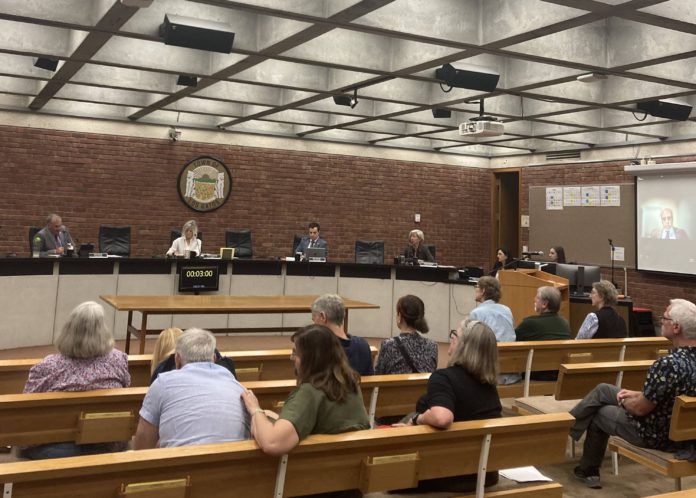
As Los Gatos prepared to finally adopt a compliant Housing Element—after 20 residential proposals were submitted during the purgatory period when the Silicon Valley community was out of line with State law, including a live one that includes a 12-story building—questions swirled about who is to blame for the 1,667 units that could be developed with fewer restrictions than normal.
In an email sent out on June 3, Councilmember Rob Moore emphasized the delays he’s found frustrating as he’s pushed to finalize a plan to allow for managed residential growth.
“Once the Town Council adopts this draft, Los Gatos will no longer be subject to the Builder’s Remedy (a state law that allows for building beyond local development standards),” he said. “I wish we could have completed this a lot sooner, but I am so glad to have gotten this crucial approval from the state!”
At a contentious Tuesday night Council meeting, in which Councilmember Rob Rennie accused Vice Mayor Matthew Hudes of trading in “b******” misinformation, Los Gatos voted 3-2 to adopt a Housing Element the State has said is up-to-standard (with Hudes and Mayor Mary Badame in opposition).
It was supposed to be in by the end of January last year. Los Gatos did adopt a Draft Element at that time, but the State found it didn’t go far enough towards addressing the inequities in the community related to housing access.
The Town was originally tasked with coming up with a residential development plan that accommodates 1,993 units of new homes.
This was a significant increase from the 2015-2023 cycle, where the Regional Housing Needs Allocation directed Los Gatos to make way for 619 new housing units.
The problem was, only 81% of these units were permitted by Dec. 31, 2021, and most of them were for wealthier individuals ($168,500 for a family of four, or more).
This time, the California Department of Housing and Community Development has been quite strict about making sure municipal homes plans will actually result in new housing stock.
But the debate about how to design a plan that satisfies the State, while still preserving the unique character of Los Gatos has raged intensely over the past few years.
On this point Vice Mayor Hudes finds himself on the other side of the fence from Moore.
Hudes tells the Los Gatan he understands the desire to build more housing, but says he’s worried that what will pop up here—on some of the most desirable land in the Bay Area—won’t actually be affordable.
“I think when you sit back and you look at it, there is a rush to development in Los Gatos that we’ve never seen before,” said the politician who recently announced his bid for reelection. “We’re significantly exceeding the State requirements.”
While Hudes has opposed many of the proposals that would’ve allowed for an easier path to homebuilding in Los Gatos—from the upzoning in lower-density areas considered when the 2040 General Plan was being developed to aspects of the Housing Element Overlay Zone that will allow for more units to go in specific areas of the community—here he’s referring to a small subset of small, multiunit development that the State has convinced Los Gatos to agree to.
A few months back, just as Los Gatos was on the verge of passing a good-to-go Housing Element, Hudes introduced a meandering motion to draw-up exceptions to where single-family zoning could be asked to give-way to a small amount of triplexes, fourplexes and similar-sized infill development.
To the surprise of some pro-housing voices, the Town reported that at least one HCD staffer seemed okay with the restrictions that included historic homes, homes next to historic homes, homes near evacuation routes, high fire hazard areas and homes not right next to a bus stop.
Hudes is frustrated that three Council members voted for a plan that removed three of these areas from the list of protected places right off the hop.
However, this list does not set out where a minor amount of housing will occur.
In fact, the small multifamily implementation program has not even been designed yet.
Nevertheless, Hudes asked staff to calculate the total number of parcels where the couple hundred new homes could be allowed to go.
Staff says this will amount to 210 units total, when what are known as Program J and Program AY are put into action over the next eight years.
However, Hudes claims this could be much higher.
He asked the Town how many parcels are available in total for these infill units.
“There are approximately 6,764 parcels available in the low and medium density designations to support the quantified objectives of Implementation Programs J and AY for small multiunit housing,” staff replied in a report, this week. “However, once implemented Programs J and AY may affect a smaller number of parcels.”
And while Los Gatos is finally at the end of the grueling Housing Element development process, the fight to protect the town’s unique flavor doesn’t end here.
“People say there’s nothing we can do—I would disagree with that,” Hudes said, arguing that drawing up new objective standards will be important in the new phase. “Getting to the end of the Housing Element takes us from one chapter and moves us to another chapter.”










[…] More than a year after the deadline, the Town passed a Housing Element that plans for more than 2,400 new units (the initial requirement amount of 1,993 units plus a buffer). […]